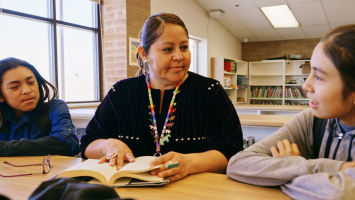Top 7 Best Ways to Boost Student Well-Being and Lower Stress
According to a survey conducted in the United States, the number of suicide attempts among students more than doubled between 2012 and 2018. Stress is ... read more...something that most people have undoubtedly experienced when sitting in class. Group assignments, quality assessment tests, final examinations, and graduation exams all put pressure on pupils in an unnoticed way. Since the outbreak, many schools have indicated growing concern about their student's health. Let's with Toplist make a list of the best ways to boost student well-being and lower stress.
-
When you are transparent and explicit about your course objectives, your students will feel more inspired and involved. Students need to be able to see where they are in the course and what they will need to do to "catch up" if they fall behind. Your syllabus and course site can provide this information. This is crucial during times when students may need to miss classes or withdraw from activities due to personal illness or a family situation.
It's crucial to be upfront and clear about what is expected of them in terms of behavior, class rules, and even individual assignments because your students will probably be primarily or entirely online. Students who take classes online or those who are preoccupied with the shifting circumstances on campus might not have the time or mental energy to ask you for clarification on a section of your syllabus that might be unclear.

Provide structure and routine 
Provide structure and routine -
To add flexibility to your course, review your syllabus and think about how your attendance and participation rules, assignment choices, and due dates can all be flexible. At the beginning of the lesson, ask students to complete a survey with information about their location, time zone, and present learning circumstances (access to the internet, private study space, necessary technology including printers, academic support, and services). With this knowledge, you may anticipate if your lesson plans will support student situations now and in the future and make necessary revisions.
Remind students frequently that they should get in touch with you if something is affecting their ability to concentrate or finish assignments in class. You may support your students by being adaptable; create choices for asynchronous study in advance so that students can reengage if they must take a break from the course for a while owing to personal reasons.

Be flexible and understanding 
Be flexible and understanding -
Sending a "welcome email" to pre-registered students 5–6 days before the course's start date is a great practice when organizing your classes. You could briefly introduce yourself and your teaching or employment situation, explain how the class will operate and how to get started on the first day of class, and include a link to your student survey if you decide to conduct one as described above. You might wish to offer this greeting in the form of a brief, two-minute video, an email, or even both.
Create channels of communication for your course, keep them up to date, and communicate frequently rather than insufficiently. Make sure your students are aware of where to locate critical information on your course website, and arrange for more frequent group check-ins via email, messaging, or other frequently used channels. To let students know what is going on in your class at any given time, use Announcements often. Also, make sure that all information is saved for later use on your course website. In all communications, adopt a warm, sympathetic tone.

Maintain open communication with your students 
Maintain open communication with your students -
While maintaining a secure, welcoming environment in the classroom is crucial at all times, it becomes even more crucial when children are under stress from outside sources. Minority and low-income students are more likely to have financial difficulties as a result of the pandemic. International students could experience issues with prejudice, visa constraints, and travel limitations. Students who commute to class may not have as many opportunities to be "out" as they would if they lived on campus.
Even if your course covers a subject that seems to have nothing to do with current affairs or culture, the political climate is stirring up tensions and worries among students that may make it difficult for some of them to talk openly or pay attention in class. Use enough wait time to allow remote students to ask questions, include them in activities, connect them with the in-person students, and address them by name when speaking with them. Make sure the remote students can see, hear, and participate fully in class activities using both the technology in your classroom and their own.

Create a safe atmosphere 
Create a safe atmosphere -
Look for ways to be inclusive and foster an online community in your course syllabus and overall course design. Set an example of inclusivity and respect for one another in your class. Small group activities, provide students the chance to introduce themselves and get to know one another. Create a shared awareness of the standards for respectful discourse, privacy, and respect in your class by using discussion guidelines. Allowing students to converse and become acclimated to the class period at the start of your in-person or "live" online session can be helpful and encourage students to concentrate on the subject at hand.
Utilize best practices for assessment to provide frequent student feedback and chances for improvement. These include scaffolded assignments, assessments that are directly related to the course's content and learning objectives, and various options for student participation to account for varying student comfort levels and preferences. Use criterion-referenced grading schemes as opposed to norm-referenced ones; that is, base your grading and students' final scores on how well they've met the assignments and the course's learning objectives rather than how they compare to their classmates (curving). Create fair and objective rubrics for each task, distribute the rubrics and sample assignments to students at the start, and grade using the rubrics.

Practice inclusive teaching 
Practice inclusive teaching -
Students with special needs will often strive if their achievements are acknowledged, and these achievements are not always restricted to academics. The teachers should also applaud their students whenever he or she exhibits willpower or maturity, such as sitting still and remaining cool when anxiety comes, maintaining self-control while furious, or hiding from others...
Set no restrictions in situations where your pupils simply need to do the correct thing in order to be rewarded. If you need to talk to them about behavioral issues, such as stress, begin by discussing the student's positive characteristics and behaviors so that he or she feels loved and welcomed.

Compliment the positive 
Compliment the positive -
Games, such as stress management escape rooms, coping skills bingo or coloring, jigsaw puzzles, and word scapes, are a fun and interactive way to educate students on social and emotional skills such as self-regulation, which can prepare them to work through stress. According to a British study, when you love a game, your brain releases dopamine - a key hormone associated with feelings of euphoria, motivation, memory, and attention. This will make you feel more at ease and provide a more enjoyable experience while playing the game.
Students participate in hands-on, interactive puzzles in these games that teach the biological stress reaction and how to handle stress by getting organized, performing exercises or yoga, relying on social supports, and so on. Furthermore, this free game teaches kids how to control anger and stress in a fun and interactive way. According to research, these types of activities can help people relax and settle their brains. You might wish to set aside time during the day to allow all pupils to participate in one of these relaxing activities. Alternatively, you may designate a quiet area where children can go to work on a jigsaw puzzle, color, and so on when they are feeling particularly worried.

Teach through games 
Teach through games




























